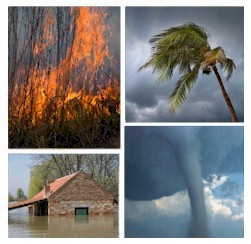|
|


Emergency Alert Systems and Services
 This section of our technical library presents articles written about Emergency Alert Systems and Disaster Recovery definitions, terms and related information.
This section of our technical library presents articles written about Emergency Alert Systems and Disaster Recovery definitions, terms and related information.
The 911Broadcast emergency notification and alert service can deliver a large number of phone calls using a network of phone systems employing digital phone lines simultaneously. Should a disaster such as a snow storm, wild fire or flood hit your area, 911Broadcast systems can alert your community quickly providing specific instructions if an evacuation is required.
This service is available using our emergency broadcasting systems. If a dangerous chemical spill occurs in your community, you can target specific areas to call. If a severe snow storm hits your area, your community can be notified of school closings or event cancellations.
Contact DSC Today for a FREE analysis and quote and to learn more about our emergency notification systems and services.
Background on the Emergency Alert System (EAS)
Reprint: www.fema.gov
The following information is provided to aid those participating in the Radiological Emergency Preparedness (REP) Program to understand the EAS. Under the EAS, State and local governments, in partnership with the broadcast and cable industries, will be afforded new ways and resources to more effectively provide emergency alerts (signal tones), information and instructions to the American public.
On December 13, 1995, the Federal Communications Commission (FCC), the National Oceanic and Atmospheric Administration (NOAA) and the Federal Emergency Management Agency (FEMA) held a joint press conference at the FCC to announce the change from EBS to the new EAS. This change represented a fundamental shift in the way State and local governments, in partnership with the broadcast industry, provide emergency information and instructions to the public. National implementation of the new EAS began on January 1, 1997, for radio and television stations and began on December 31, 1998, for cable systems with 10,000 or more subscribers. For cable systems with fewer than 10,000 subscribers and for wireless cable systems regardless of the number of subscribers, the effective date for participation will be October 1, 2002.
This change was effected through the use of digital technology that will make it possible for State and local governments and the broadcast industry to automate methods and processes to provide emergency alerts, information and instructions to the public. The use of digital technology for this purpose built upon the use of the new Weather Radio Specific Area Message Encoder (WRSAME) technology developed by NOAA. The specific types of digital technology used with the EAS are encoders and decoders. This equipment functions in a similar fashion as computers except it is tailored to the specific requirements of providing emergency instructions to the public through radio and television broadcasts. The specifications for the new digital equipment have been promulgated by the FCC in its Rule and Order and is contained in the interim-use FEMA document Emergency Alert System, CPG 1-40 (June 1996). The digital technology equipment has been certified by the FCC to meet these specifications, and has been purchased by the broadcast media.
The use of digital technology provides many benefits over methods formerly used in the EBS. Through the automation of the transfer of information from State and local governments to broadcast stations and finally to the public, the public can be notified much faster and more efficiently. (For example, State and local governments may send emergency instructions to the public within seconds, rather than minutes.) Since all broadcast media were required to purchase the new technology, there is a built-in redundancy to ensure reception of emergency messages by the public.
Equipment located at broadcast stations may function either on an automatic or manual mode. Under the automatic mode, State and local governments may transmit emergency instructions to the public through radio, television and cable stations on a 24-hour basis without the broadcast industry staff's presence or intervention. This is accomplished on an individual basis with each broadcaster and cable operator. The broadcaster or cable operator must set the EAS equipment to auto-forward the message. All EAS messages contain a unique code imbedded in the EAS digital header signal. If the imbedded codes in the EAS equipment match the codes of the incoming message from the government office, the message will be aired automatically.
Some EAS equipment models incorporate a "semi-automatic mode" that delays retransmission of an EAS message. This delay feature allows operators to review the message before it is transmitted over the broadcast station or cable system. The delay usually lasts 15 minutes after which the message is automatically transmitted.
In addition to permitting faster transmission of emergency information and instructions to the public, emergency messages may be targeted to very specific areas impacted by hazards. State and local governments may request activation of the EAS from field locations, provided those arrangements and communications links are agreed to in advance.
An important change resulting from the use of digital technology is the time constraint built into the processing of emergency alerts and instructions. Based on FCC specifications [Section 11.33(a)(3)(i) of its EAS Rule and Order], the storage capacity of the new EAS digital equipment is set at two minutes. Because of this memory constraint, the length of emergency alert and instructional messages will need to be reviewed and perhaps revised. While additional memory may be added, at minimal cost, to permit longer messages, it will be necessary to retrofit all digital equipment of State and local governments and participating broadcast industries within an operational area(s) to ensure message compatibility. However, if additional memory is desired, it should be determined if equipment within an operational area is adaptable to memory expansion. This technological constraint will require that State and local governments develop new and coordinated approaches to providing emergency alerts and instructions to the public, particularly for hazards like those addressed in the REP Program that may impact large populations. In addition, State and local governments, if adding more memory, need to work with the State and Local Emergency Communications Committees to ensure compatibility of their equipment.
As a condition of licensing, all radio and television stations were mandated by the FCC to purchase and install FCC-certified equipment for implementation of the EAS by January 1, 1997. While waivers are permitted in the FCC's Rule and Order for the broadcast industry, it is not likely that waivers will be granted for stations within the continental United States. State and local governments are not required to participate in the EAS nor to purchase, install and use the new digital equipment.
There are two contexts in which the EAS will be used--Presidentially-initiated alerts and messages and those initiated by State and local governments in concert with the broadcast industry. For Presidentially-initiated alerts and messages, there are 30 radio and television stations that are required to broadcast such transmissions to the American public for national security emergencies. The stations selected for this national system are referred to as National Primary Stations under the EAS.
Radio and television stations are not required to broadcast alerts and messages initiated by State and local governments. Under FCC authorities, the final authority for the broadcast of messages initiated by State and local governments resides with the broadcaster, not the State and local government. The FCC, however, encourages licensees to broadcast emergency alerts as a public service; use of emergency system broadcasting through the EAS is considered part of this service. Thus, if the EAS is used, it is critical that State and local governments work closely with their local broadcast industry representatives and State and Local Emergency Communication Committees to establish agreed-upon protocols to avoid problems in communicating emergency messages to the public during actual emergencies.
Severe Weather Warnings And Alerts Phone Service
 Should a severe weather condition occur in your area, our phone services can help warn your community. With our emergency notification phone service, you can broadcast warning messages to thousands of households in your community, warning of catastrophic disasters including severe weather and storms.
Should a severe weather condition occur in your area, our phone services can help warn your community. With our emergency notification phone service, you can broadcast warning messages to thousands of households in your community, warning of catastrophic disasters including severe weather and storms.
Messages can be simultaneously delivered in just minutes using our network of phone systems and services. Pre-recorded warning messages can be played giving households information regarding the severe weather location and whether a community evacuation is planned or necessary.
You can send a broadcast warning to specific neighborhoods or communities in the event of a severe weather storm and provide priority delivery of these messages to those nearest the severe weather disturbance. Multiple messages can be delivered to different members of the community based upon proximity to the weather alert.
Calls can be directed to operators that are standing by to handle special individual emergencies.
Messages can also be broadcast seeking volunteers or special assistance from emergency personnel.
 Other applications include warning residents when the danger of severe weather conditions is at a high level. Travel and activity restrictions can likewise be broadcast using this service.
Other applications include warning residents when the danger of severe weather conditions is at a high level. Travel and activity restrictions can likewise be broadcast using this service.
Severe weather warning messages sent to households in this fashion can be simple warnings with specific or general instructions. If the community needs feedback from the call, an interactive response can be programmed into the message allowing the person to either acknowledge the call or to contact someone. Messages can vary based upon proximity to the event, with different degrees of broadcast warning and instructions.
To learn more about our severe weather and emergency response / disaster recovery phone service, please visit our Emergency Broadcast System web page.
Contact DSC Today for a FREE analysis and quote and to learn more about our emergency notification systems and services.
|




 This section of our technical library presents articles written about Emergency Alert Systems and Disaster Recovery definitions, terms and related information.
This section of our technical library presents articles written about Emergency Alert Systems and Disaster Recovery definitions, terms and related information.
 Should a severe weather condition occur in your area, our phone services can help warn your community. With our emergency notification phone service, you can broadcast warning messages to thousands of households in your community, warning of catastrophic disasters including severe weather and storms.
Should a severe weather condition occur in your area, our phone services can help warn your community. With our emergency notification phone service, you can broadcast warning messages to thousands of households in your community, warning of catastrophic disasters including severe weather and storms.
 Other applications include warning residents when the danger of severe weather conditions is at a high level. Travel and activity restrictions can likewise be broadcast using this service.
Other applications include warning residents when the danger of severe weather conditions is at a high level. Travel and activity restrictions can likewise be broadcast using this service.